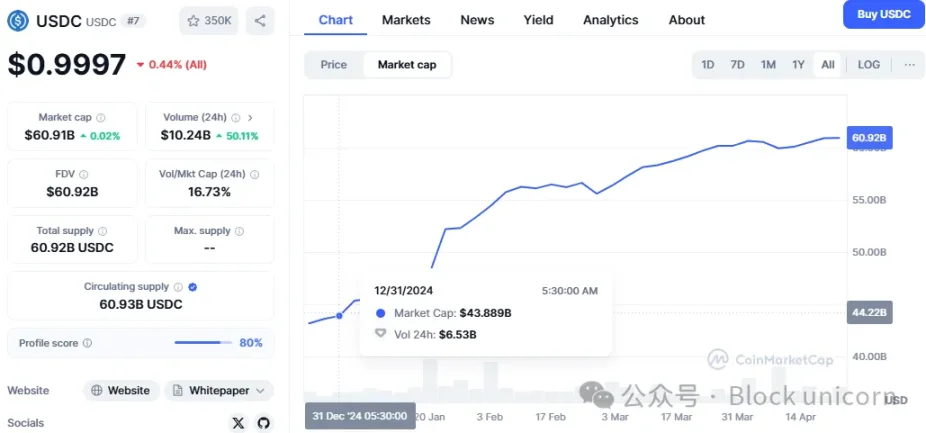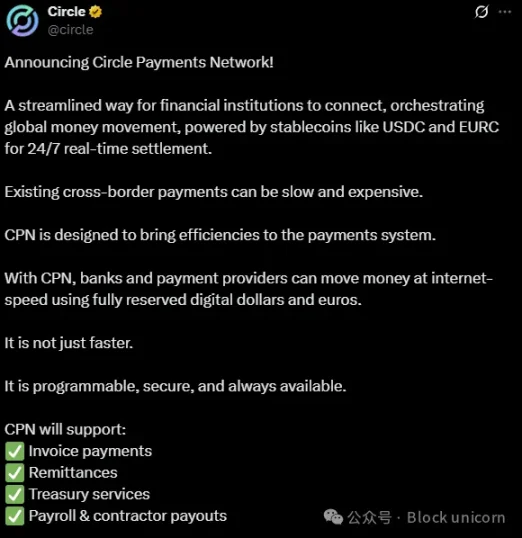Circle is actively expanding in multiple areas such as payment networks, bank license applications, and institutional partnerships, while gradually closing the gap with market leader Tether.
Written by: Prathik Desai, Nameet Potnis, Thejaswini M A
Translated by: Block unicorn
Introduction
Despite the market turmoil caused by U.S. President Donald Trump's tariff policies, which temporarily halted Circle's IPO plans, the company is rapidly advancing towards its anticipated IPO.
Circle is actively positioning itself in various fields—payment networks, bank license applications, and institutional partnerships—while gradually closing the gap with market leader Tether. For instance, the issuer of USDC has narrowed its market share gap with Tether from 50 percentage points to just 35 percentage points.
In today's article, we will explore:
- The accelerated growth of USDC and the narrowing gap with Tether
- How Circle's new payment network is set to replace outdated cross-border systems
- Why Circle and other crypto companies are suddenly racing to apply for bank licenses
- How traditional banks are preparing to counterattack against stablecoins
Let’s first discuss why the competition in stablecoins is so important beyond the cryptocurrency bubble.
$2 Trillion Stablecoin Race
The competition in stablecoins is intensifying. As regulations become clearer, traditional financial giants are preparing to take action, which could disrupt the current duopoly held by Tether and Circle.
Over the past five months, the combined market share of the two major stablecoins has decreased by 4 percentage points.

Ran Goldi, Senior Vice President of Payments at Fireblocks, stated in an interview with Coindesk: "We will see banks issuing stablecoins because they comply with MiCA requirements. By the end of this year, you might see more than 50 new stablecoins."
A report from Standard Chartered indicates that by the end of 2028, the stablecoin market could soar to an astonishing $2 trillion, nearly ten times the current total supply of $235 billion.
Dozens of banks are privately drafting strategic plans for stablecoins, with most expected to finalize their proposals by the end of this quarter. Goldi noted, "It will be interesting to see whether banks develop their own solutions, leverage platforms from service banks like BNY Mellon, or use providers like Fireblocks."
This imminent competitive threat explains why Circle is acting so urgently across multiple fronts. As traditional financial institutions prepare to enter the market, the window for solidifying market position is rapidly closing.
Escalating Stablecoin Competition
The intentions and rapid actions of USDC are evident: as of April 19, its market capitalization has climbed to over $60 billion, an increase of $17 billion from $44 billion at the beginning of the year, representing a growth of about 40%.

In contrast, Tether's USDT saw only an 8% increase in market capitalization during the same period. Although Tether maintains a dominant position with nearly 2.5 times the market cap of USDC, the growth gap is rapidly narrowing.
USDT's market share dominance has declined by nearly 10 percentage points over the past five months to 61.85%, while Circle has risen by about 6 percentage points.

Data shows that the preference gap between the two stablecoins is widening. Regulated entities and DeFi protocols favor USDC due to Circle's clear and transparent regulatory framework.
This advantage is most pronounced in Europe. USDC has obtained MiCA licensing, allowing it to cover 27 EU countries, reaching a total population of 450 million. In contrast, USDT does not have this.
Regulators are not the only obstacle to Tether's continued dominance.
Coinbase CEO Brian Armstrong recently stated that the exchange's new "ambitious goal" is to replace Tether's USDT and become the world's "number one dollar stablecoin."
Other exchanges, such as Kraken and Crypto.com, have also delisted USDT from the European market.
Breaking the Banking Mold
On Tuesday, Circle launched a product aimed at reducing the costs and delays of cross-border money transfers. The Circle Payment Network (CPN) aims to leverage stablecoins as a bridge to dismantle the outdated infrastructure of global finance.
Circle posted on X: "We are not just building stablecoins; we are building modern infrastructure for global payments."

It is well known that international banking is slow, costly, and constrained by traditional systems that often shut down during nights and weekends. Circle's alternative promises instant transfers around the clock using fully reserved digital dollars (USDC) and euros (EURC).
Circle has brought in over 20 design partners, including dLocal, WorldRemit, BVNK, Yellow Card, and Coins.ph.
This lineup of partners indicates a clear focus on institutions in emerging markets and high-traffic remittance corridors—areas where traditional banking has notably underperformed.
Circle's network initiative has a simple yet fundamental rationale—to transform stablecoin issuers into key financial infrastructure providers for moving these assets at scale.
An insider stated, "Circle is launching a payment network, initially targeting remittances, but ultimately aiming to compete with Mastercard and Visa."
Banking Strategy
While launching its payment network, Circle is reportedly preparing to navigate regulatory hurdles to apply for a U.S. bank license or charter, according to The Wall Street Journal.
However, Circle is not alone in this endeavor. The custodial institution for the Trump family stablecoin USD1, BitGo, along with Coinbase and Paxos, is also on the same path. This comes at a time when U.S. stablecoin regulations are evolving, which may soon require stablecoin issuers to obtain licenses.
Why pursue a bank license now?
A bank license would allow Circle to operate like a traditional bank, potentially including accepting deposits and issuing loans.
But this also comes with high costs. Reports indicate that crypto company Anchorage Digital spent millions to comply with regulatory requirements after obtaining a federal charter.
However, the potential rewards could be substantial—namely, access to a Federal Reserve master account, a "holy grail" that crypto-native banks like Custodia have failed to achieve for years. This access would provide Circle with the closest channel to the U.S. money supply available to financial institutions.
Our Perspective
Circle's multi-pronged strategy indicates that it is preparing not just for positioning ahead of its IPO, but for a deeper attempt to bridge the gap between traditional finance and the crypto space, a gap that other stablecoin issuers have yet to successfully cross.
Circle's institutional-grade payment network, ambitions for a bank license, and the regulated status of USDC collectively create an unprecedented moat against Tether and the traditional financial competitors that are about to enter the market. Circle is laying a solid foundation across diverse areas to build significant differentiation from its competitors.
Notably, Circle's focus on emerging markets and remittance corridors stands out. While competitors vie for dominance in mature Western markets, Circle is quietly expanding, building infrastructure in regions where financial inclusion remains elusive.
Its partner list—dLocal (South America), WorldRemit (Africa and Asia remittances), Yellow Card (Africa), Coins.ph (Philippines)—serves as a roadmap for the next generation of remittance markets.
Relative to Tether, the licensing advantage under MiCA may be Circle's most underrated asset. Gaining regulatory compliance to access 450 million European users undoubtedly creates a winner-takes-all scenario.
Circle's strategy demonstrates their understanding of a fundamental truth—the victory in the stablecoin war depends not only on market share but also on infrastructure, regulatory positioning, and institutional integration.
Circle is well aware that it cannot surpass Tether's market capitalization in the short term, so it is building an entirely different realm where Tether, despite its size, cannot compete with its existing capabilities.
免责声明:本文章仅代表作者个人观点,不代表本平台的立场和观点。本文章仅供信息分享,不构成对任何人的任何投资建议。用户与作者之间的任何争议,与本平台无关。如网页中刊载的文章或图片涉及侵权,请提供相关的权利证明和身份证明发送邮件到support@aicoin.com,本平台相关工作人员将会进行核查。




